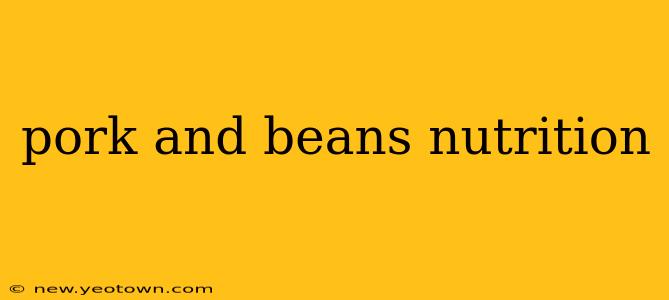Pork and beans. The name conjures images of hearty meals, comforting aromas, and perhaps even a slightly nostalgic feeling. But beyond the deliciousness, what's the nutritional story behind this classic dish? Let's dive into the nutritional profile of pork and beans, exploring its benefits and potential drawbacks.
This isn't your grandma's recipe (unless your grandma was a nutritional whiz!). We're going beyond the basics, exploring the nuances of different types of pork and beans, the impact of preparation methods, and how this dish fits into a balanced diet.
What are the nutritional benefits of pork and beans?
Pork and beans are a surprisingly good source of several essential nutrients. The beans themselves are packed with fiber, protein, and various vitamins and minerals. The pork adds protein and fat, contributing to satiety and overall caloric content. Let's break it down:
-
Fiber: Beans are fiber powerhouses! This aids digestion, regulates blood sugar, and contributes to a healthy gut microbiome. High fiber intake is also linked to lower cholesterol and reduced risk of heart disease.
-
Protein: Both the beans and pork contribute significantly to your daily protein needs. Protein is crucial for building and repairing tissues, supporting immune function, and maintaining muscle mass.
-
Iron: Beans are a good source of iron, an essential mineral for oxygen transport throughout the body. Combining iron-rich beans with a source of vitamin C (like adding some bell peppers or tomatoes to your recipe) can boost iron absorption.
-
Potassium: This important electrolyte helps regulate blood pressure and fluid balance. Beans are a good source of potassium.
-
Other Vitamins and Minerals: Pork and beans also provide smaller amounts of various other vitamins and minerals, including folate, magnesium, and zinc.
Are pork and beans high in fat and sodium?
This is a crucial question, as many canned pork and beans are high in both fat and sodium. The type of pork used, the added ingredients, and the canning process all impact the final nutritional profile.
Fat: While pork does contain fat, the amount varies depending on the cut of meat used. Leaner cuts of pork will result in a lower-fat dish. The fat content can also be significantly affected by the cooking method; recipes that call for excess oil or fat will clearly increase the overall fat content.
Sodium: This is where many commercially canned pork and beans stumble. Manufacturers often add significant amounts of sodium for preservation and flavor enhancement. Reading nutrition labels carefully and choosing low-sodium varieties is essential. Making your own pork and beans allows for greater control over the sodium content.
How many calories are in a serving of pork and beans?
The calorie count of pork and beans varies dramatically depending on the serving size, ingredients, and preparation method. A typical serving of canned pork and beans can range from 200-300 calories or more. Homemade versions can have fewer calories, depending on the ingredients used.
Are pork and beans good for weight loss?
The high fiber and protein content of pork and beans can contribute to feelings of fullness and satiety. This can be helpful for weight management, as it helps control appetite and prevents overeating. However, the high calorie and sodium content of some varieties can be detrimental to weight loss efforts. Opting for lower-sodium, homemade versions with leaner pork and controlling portion sizes is key for anyone using pork and beans as part of a weight-loss strategy.
What are the downsides of eating pork and beans?
While generally a healthy food, pork and beans do have some potential downsides:
- High Sodium: As mentioned earlier, high sodium intake is a concern for some individuals.
- Gas and Bloating: The high fiber content can cause gas and bloating in some people. Starting with smaller portions and gradually increasing intake can help your body adjust.
- Phytic Acid: Beans contain phytic acid, which can interfere with the absorption of certain minerals. Soaking beans before cooking can help reduce phytic acid levels.
What are some healthy ways to prepare pork and beans?
Making your own pork and beans allows for complete control over the ingredients and nutritional profile. Using lean cuts of pork, reducing or eliminating added sugars and sodium, and incorporating plenty of vegetables can significantly enhance the nutritional value. Consider adding ingredients like onions, garlic, bell peppers, and tomatoes for additional flavor and nutrients.
By understanding the nutritional components of pork and beans and making informed choices about preparation and serving sizes, you can enjoy this classic dish as part of a healthy and balanced diet. Remember, moderation and mindful eating are key.

